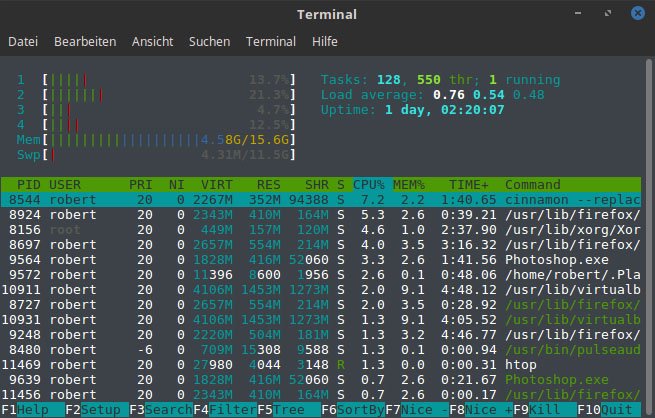

- Hypervisor linux cpuinfo how to#
- Hypervisor linux cpuinfo install#
- Hypervisor linux cpuinfo 32 bit#
- Hypervisor linux cpuinfo software#
- Hypervisor linux cpuinfo free#
The /proc/cpuinfo virtual file contains a lot of information about the CPUs installed in our system. The following methods show the most useful tools, which are installed by default on almost any Linux distribution. There are several command line utilities we can use to obtain CPU information on Linux. $ – requires given linux commands to be executed as a regular non-privileged userĬheck CPU instruction set via command line # – requires given linux commands to be executed with root privileges either directly as a root user or by use of sudo command Privileged access to your Linux system as root or via the sudo command.
Hypervisor linux cpuinfo software#
Requirements, Conventions or Software Version Used
Hypervisor linux cpuinfo how to#
How to check CPU instruction set Software Requirements and Linux Command Line Conventions Category
Hypervisor linux cpuinfo install#
How to install hardinfo GUI program on major Linux distros.How to check CPU instruction set from command line and GUI.On a related note, check out our guide on how to check and monitor CPU utilization if you want to measure the performance of your CPU.
Hypervisor linux cpuinfo 32 bit#
This will also include information about whether the CPU is 32 bit or 64 bit. In this tutorial, we will see how to obtain the CPU instruction set on Linux, from both command line and GUI. This means it is perfectly accessible for normal users, we just have to know where to look. Information about the instruction set of your CPU is stored in Linux, at the operating system level. For example, if your CPU supports hardware virualization, then that is part of its instruction set. The instruction set of a CPU is, in simple terms, the capabilities that it possesses. Model Name: MacBook Air Model Identifier: MacBookAir6,2 Processor Name: Intel Core i5 Processor Speed: 1.3 GHz Number of Processors: 1 Total Number of Cores: 2 L2 Cache (per Core): 256 KB 元 Cache: 3 MB Memory: 8 GB Boot ROM Version: 04 SMC Version (system): 2.The purpose of this tutorial is to show how to check a CPU’s instruction set on a Linux system. List CPU info with: $ system_profiler SPHardwareDataType
Hypervisor linux cpuinfo free#
The throughput was 4000mb/176sec = 22.73 MB/s CPU LinuxĬPU info is in the virtual file /proc/cpuinfo: $ cat /proc/cpuinfo processor : 0 vendor_id : GenuineIntel cpu family : 6 model : 45 model name : Intel(R) Xeon(R) CPU E5-2650 0 2.00GHz stepping : 7 microcode : 0x70d cpu MHz : 1795.672 cache size : 20480 KB physical id : 1 siblings : 2 core id : 2 cpu cores : 1 apicid : 36 initial apicid : 36 fpu : yes fpu_exception : yes cpuid level : 13 wp : yes flags : fpu de tsc msr pae cx8 sep cmov pat clflush mmx fxsr sse sse2 ss ht syscall nx lm constant_tsc rep_good nopl nonstop_tsc pni pclmulqdq ssse3 cx16 pcid sse4_1 sse4_2 x2apic popcnt tsc_deadline_timer aes hypervisor lahf_lm arat epb xsaveopt pln pts dtherm bogomips : 3591.34 clflush size : 64 cache_alignment : 64 address sizes : 46 bits physical, 48 bits virtual power management: processor : 1 vendor_id : GenuineIntel cpu family : 6 model : 45 model name : Intel(R) Xeon(R) CPU E5-2650 0 2.00GHz stepping : 7 microcode : 0x70d cpu MHz : 1795.672 cache size : 20480 KB physical id : 1 siblings : 2 core id : 2 cpu cores : 1 apicid : 36 initial apicid : 36 fpu : yes fpu_exception : yes cpuid level : 13 wp : yes flags : fpu de tsc msr pae cx8 sep cmov pat clflush mmx fxsr sse sse2 ss ht syscall nx lm constant_tsc rep_good nopl nonstop_tsc pni pclmulqdq ssse3 cx16 pcid sse4_1 sse4_2 x2apic popcnt tsc_deadline_timer aes hypervisor lahf_lm arat epb xsaveopt pln pts dtherm bogomips : 3591.34 clflush size : 64 cache_alignment : 64 address sizes : 46 bits physical, 48 bits virtual power management: Memory $ free total used free shared buffers cached Mem: 8014548 6649104 1365444 0 999756 3663824 -/+ buffers/cache: 1985524 6029024 Swap: 262136 27172 234964 MacOSX

On the server, send a 4GB file to client: $ sudo time bash -c "(nc -w 3 1234 < tmp.dat)" real 2m56.656s user 0m1.612s sys 0m15.088s

On the client, run netcat listener: $ nc -l 1234 > tmp.dat Use netcat to transfer a 4GB file from one VM to another VM: Use dd to write bytes to disk: $ sync sudo time bash -c "(dd if=/dev/zero of=tmp.dat bs=8k count=500000 sync)"ĥ00000+0 records in 500000+0 records out 4096000000 bytes (4.1 GB) copied, 34.3706 s, 119 MB/s Network performance


 0 kommentar(er)
0 kommentar(er)
